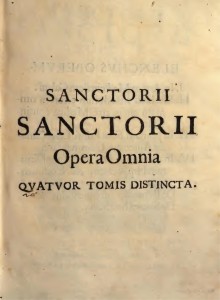Santorio’s output occupies four volumes of an edition in 4° published in Venice in 1660 by Francesco Brogiolo, which also hosts the only known portrait of him.
The first volume contains the ‘Commentary on Galen’s Ars medica’ (Commentaria in Artem medicinalem Galeni);
the second the ‘Method to avoid all errors that happen in medical art’, in fifteen books (Methodi vitandorum errorum omnium, qui in arte medica contingunt libri quindecim);
the third the ‘Commentary on the first Fen of the first book of Avicenna’s Canon’ (Commentaria in primam Fen primi libri Canonis Avicennae);
the fourth and last the ‘Commentary on the first section of Hippocrates aphorisms’ (Commentaria in primam sectionem Aphorismorum Hippocratis), the‘Invention of cures’ (De remediorum inventione) and the‘Medical statics’ (Ars de statica medicina).
The progression does not reflect any chronological need but is intended for didactical purposes, from the conventional to the more innovative works.
Indeed, the first book published by Santorio was the Methodi vitandorum errorum omnium (Venice 1602, apud societatem), a work that could be easily regarded as a methodological introduction to his thought and that also allows us to look closer to his background, as it shows Santorio’s studies as well as his scientific commitment.
It was this book on differential diagnosis that established his fame and that, coupled with the strength of his social connections, led to the invitation to serve as professor of theoretical medicine at the University of Padua. As the title declares, the book would present a method to avoid all errors that happen in medical practice by focusing on experience, analogy and deduction. The work is also clearly reminiscent of the influence of Jacopo Zabarella (1533-1589), Santorio’s teacher in Padua and one of the most important logicians of the XVI century, celebrated author of the Opera logica (Venice 1578) whose sections show a particular emphasis for methodological questions.
Santorio will rely also on another of Zabarella’s works, the ‘De naturalibus rebus libri XXX’ (published in Venice in 1590), as far as it concerns his major notions of physiological optics. The Methodi vitandorum errorum omnium…libri XV is also important as it testifies early interest by Santorio for quantification, especially as far as it regards mixtures (book VII, chap. 9) and quantification of drugs (Book XIII, chap. 1-2) as well as for the description of an instrument of precision, the so called pulsilogium, or pulsimeter, which the author claimed to have invented.
Santorio Santorio and the Emergence of Quantifying Procedures in Medicine at the End of the Renaissance
Philosophy, Medicine and Science in the Early Modern Period

